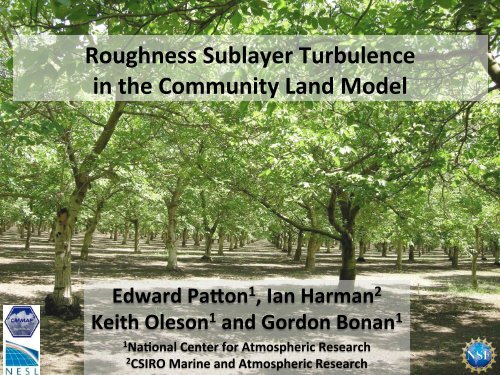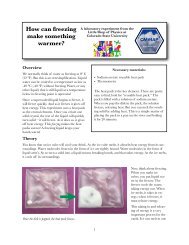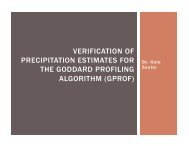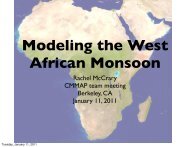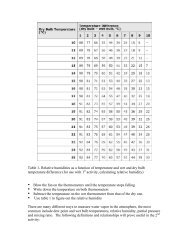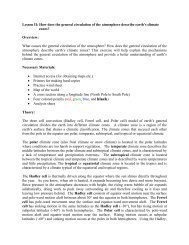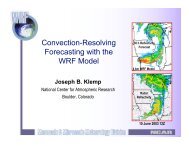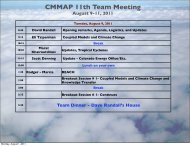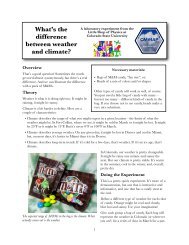Roughness Sublayer Turbulence in the Community Land ... - cmmap
Roughness Sublayer Turbulence in the Community Land ... - cmmap
Roughness Sublayer Turbulence in the Community Land ... - cmmap
You also want an ePaper? Increase the reach of your titles
YUMPU automatically turns print PDFs into web optimized ePapers that Google loves.
<strong>Roughness</strong> <strong>Sublayer</strong> <strong>Turbulence</strong> <br />
<strong>in</strong> <strong>the</strong> <strong>Community</strong> <strong>Land</strong> Model <br />
Edward Pa
Canopy turbulence and <strong>the</strong> roughness sublayer <br />
0<br />
W<strong>in</strong>d speed <br />
<strong>in</strong>creas<strong>in</strong>gly unstable <br />
z-d<br />
L = 0 .016 0.045 -0.065 -0.085 -0.107 -0.306<br />
Poten6al temperature <br />
-0.03 -0.047 -0.065 -0.082 -0.104 -0.239<br />
z-d<br />
L<br />
-1<br />
-2<br />
-3<br />
OBS<br />
MOST<br />
N = 18<br />
43<br />
50<br />
33<br />
33<br />
49<br />
2 1<br />
N = 13<br />
36<br />
48<br />
26<br />
30<br />
60<br />
Flow with<strong>in</strong> 2-‐3 canopy heights above/with<strong>in</strong> tall (plant) canopies does not conform to <br />
Mon<strong>in</strong>-‐Obukhov Similarity Theory (M-‐O); this region is called <strong>the</strong> roughness sublayer (RSL). <br />
Raupach (1976), Chen and SchwerdPeger (1989)
Theory for canopy-‐structure forma6on <br />
F<strong>in</strong>nigan, Shaw and PaRon (2009)
Simple roughness sublayer <strong>the</strong>ory <br />
§ Extensive use of scal<strong>in</strong>g arguments & 1 st order turbulence closures <br />
§ With<strong>in</strong> canopy: <br />
§ Mass / momentum balance for horizontally homogeneous canopy <br />
§ Canopy characterised by adjustment length, L c (Stanton number rc) <br />
§ Above Canopy: <br />
§ Displacement height: Height of mean canopy drag momentum absorp6on <br />
§ Modified M-‐O <br />
§ Modifica6on <strong>in</strong>troduces an addi6onal length scale – vor6city thickness <br />
from <strong>in</strong>stability process (δ ω ) <br />
§ Couple two toge<strong>the</strong>r <br />
§ requires an observable value for β = u * (h) / U(h) <br />
§ rema<strong>in</strong><strong>in</strong>g parameters <strong>in</strong> both profiles fixed by match<strong>in</strong>g canopy-‐top <br />
means and fluxes <br />
Ø roughness lengths and displacement height are func6ons of <strong>the</strong> flow <br />
Harman and F<strong>in</strong>nigan (2007, 2008)
Comparison with observa6ons – Neutral condi6ons <br />
LAI ~ 2 <br />
β = 0.31 <br />
Tumbarumba <br />
LAI ~ 3 <br />
β = 0.39 <br />
Duke <br />
LAI ~3.8 <br />
β = 0.28 <br />
<strong>in</strong>creas<strong>in</strong>gly dense <br />
Harman and F<strong>in</strong>nigan (2007)
Comparison with observa6ons – Unstable condi6ons <br />
β = 0.36 β = 0.39 β = 0.44 <br />
<strong>in</strong>creas<strong>in</strong>gly unstable <br />
Profiles from <strong>the</strong> CSIRO flux sta6on near Tumbarumba <br />
Harman and F<strong>in</strong>nigan (2007)
Comparison with observa6ons -‐ stable condi6ons <br />
β = 0.37 β = 0.29 β = 0.26 <br />
<strong>in</strong>creas<strong>in</strong>gly stable <br />
Profiles from <strong>the</strong> CSIRO flux sta6on near Tumbarumba <br />
rema<strong>in</strong>s an empirical parameter vary<strong>in</strong>g with stability <br />
Harman and F<strong>in</strong>nigan (2007)
Comparison with observa6ons -‐ scalar profiles <br />
unstable ~neutral stable <br />
Similar agreement for water vapor concentra6on but not for CO 2 concentra6on <br />
Harman and F<strong>in</strong>nigan (2008)
RSL impact on CLM4 surface fluxes (diurnal cycle) <br />
• Howland Forest, ME <br />
• Average over <strong>the</strong> 1996 <br />
grow<strong>in</strong>g season -‐ DOY <br />
153 to 244 <br />
• Offl<strong>in</strong>e simula6on -‐ <br />
driven by observa6ons <br />
• Currently only <br />
modify<strong>in</strong>g above-canopy<br />
flux-‐gradient <br />
rela6onships
Surface flux comparison -‐ Obs vs. M-‐O or RSL <br />
M-‐O <br />
RSL <br />
• Howland Forest, ME <br />
• 1996 grow<strong>in</strong>g season -‐ DOY 153 to 244 <br />
• Offl<strong>in</strong>e simula6on -‐ driven by observa6ons
RSL impact on CLM4 surface fluxes (diurnal cycle) <br />
• UMBS, MI <br />
• Average over <strong>the</strong> 2000 <br />
grow<strong>in</strong>g season -‐ DOY <br />
152 to 243 <br />
• Offl<strong>in</strong>e simula6on -‐ <br />
driven by observa6ons <br />
• Currently only <br />
modify<strong>in</strong>g above-canopy<br />
flux-‐gradient <br />
rela6onships
Surface flux comparison -‐ Obs vs. M-‐O or RSL <br />
M-‐O <br />
RSL <br />
• UMBS, MI <br />
• 2000 grow<strong>in</strong>g season -‐ DOY 152 to 243 <br />
• Offl<strong>in</strong>e simula6on -‐ driven by observa6ons
Summary and Conclusions <br />
• Introduced physically-‐based roughness sublayer <br />
parameteriza6on <strong>in</strong>to CLM <br />
• Generally improves CLM’s surface flux predic6ons when tested <br />
<strong>in</strong> offl<strong>in</strong>e mode <br />
• Need to iden6fy mechanisms responsible for stomatal <br />
shutdown (i.e., overly high leaf temperatures). <br />
• Next steps: <br />
- Coupled mode <br />
- With<strong>in</strong>-‐canopy transport <br />
- Reac6ve chemistry (VOCs)
Ques6ons?


